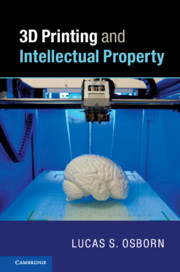Book contents
- 3D Printing and Intellectual Property
- Reviews
- 3D Printing and Intellectual Property
- Copyright page
- Contents
- Acknowledgments
- Abbreviations
- Introduction
- 1 3D Printing Technology’s Capabilities and Effects
- 2 How 3D Printing Works and Why it Matters
- 3 Primer on Intellectual Property Law
- 4 Can You Patent a 3D Printable File? (and Why it Matters)
- 5 Patents – Direct Infringement, Individual Infringement, and “Digital” Infringement
- 6 Patents – Indirect Infringement and Intermediaries
- 7 3D Printing and Trademarks: The Dissociation Between Design and Manufacturing
- 8 Creativity and Utility: 3D Printable Files and the Boundary Between Copyright and Patent Protection
- 9 Design Rights, Tangibility, and Free Expression
- 10 DMFs and Optimizing Innovation Incentives
- Conclusion
- Index
7 - 3D Printing and Trademarks: The Dissociation Between Design and Manufacturing
Published online by Cambridge University Press: 24 July 2019
- 3D Printing and Intellectual Property
- Reviews
- 3D Printing and Intellectual Property
- Copyright page
- Contents
- Acknowledgments
- Abbreviations
- Introduction
- 1 3D Printing Technology’s Capabilities and Effects
- 2 How 3D Printing Works and Why it Matters
- 3 Primer on Intellectual Property Law
- 4 Can You Patent a 3D Printable File? (and Why it Matters)
- 5 Patents – Direct Infringement, Individual Infringement, and “Digital” Infringement
- 6 Patents – Indirect Infringement and Intermediaries
- 7 3D Printing and Trademarks: The Dissociation Between Design and Manufacturing
- 8 Creativity and Utility: 3D Printable Files and the Boundary Between Copyright and Patent Protection
- 9 Design Rights, Tangibility, and Free Expression
- 10 DMFs and Optimizing Innovation Incentives
- Conclusion
- Index
Summary
Chapter 7 describes how 3D printing technology will disrupt trademark law’s core function of indicating the source or origin of manufactured goods. The technology dissociates product design from product manufacturing. Design is embodied in a 3D printable file, while manufacturing is commoditized and democratized. When 3D printable files, as opposed to manufactured goods, are offered for sale, symbols appearing “inside” of the digital files (i.e., on the digital object) do not indicate the source of the file. Rather, source indicators are found “outside” of the file, on the websites that offer the files for sale. 3D printing technology will also radically disrupt the doctrine of post-sale confusion. At the same time, current, expanded theories of trademark law condemn uses of symbols that might dilute a trademark or suggest a connection to a trademark owner. These stronger versions of trademark protection, which are widely criticized, would give trademark owners to the right to control most uses of their marks “inside” of files. This would inhibit innovation and creative expression without a clear benefit to the public. Therefore, I recommend against these stronger protections for DMFs.
Keywords
- Type
- Chapter
- Information
- 3D Printing and Intellectual Property , pp. 121 - 142Publisher: Cambridge University PressPrint publication year: 2019
- 1
- Cited by



